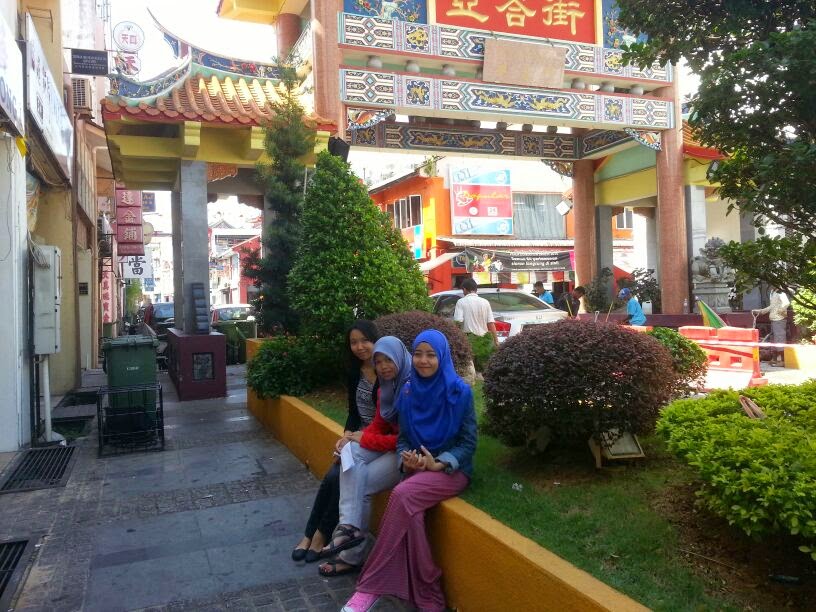Historical Building in Kuching, Sarawak, Malaysia
Great, interesting places to be visit in Kuching, Sarawak, Malaysia. Do not miss-out this few historical buildings.
Thursday, 7 August 2014
The Carpenter Street
Carpenter Street or Jalan Carpenter is an old street in Kuching. It runs from Jalan Tun Abang Haji Openg, where the General Post Office is located, to Jalan Ewe Hai to the east, immediately behind the Main Bazaar. Due to its location, it is considered the backstreet to Main Bazaar, which acted as the main thoroughfare fronting the river. In the old days, Carpenter Street was called "attap street" because of the thatch houses on both sides. This was where carpenters set up their workshop, earning the street its name.
A facelift took place in 1884, by courtesy of a big fire that razed all the wooden houses along the street. Charles Brooke, the then White Rajah of Sarawak, issued a decree that henceforth the houses to be rebuilt with non inflammable material. This necessitated the construction of the more permanent brick shophouses along Carpenter Street, a few of them surviving till today. During those days, Carpenter Street was a lower working class neighbourhood filled with opium dens, gambling joints, brothels and other clandestine activities. These were eventually cleaned up by the British.
Adjacent the Waterfront, the Main Bazaar is the oldest street in the city and the heart of old Kuching. It has some superb examples of Chinese shophouse architecture, many of which have been occupied by the same family for generations.
These families still pursue traditional occupations such as tin-smithing,carpentry and petty trading. Kuching's highest concentration of antique and handicraft shops are to be found here, and shoppers can rest between bargaining sessions in a number of old-fashioned coffee shops with panelled walls and marble-topped tables. Jalan Carpenter, which is parallel to Main Bazaar, has a similar selection of small traders and coffee shops, as well as food stalls and two small Chinese temples.
The whole area oozes charm and character. For aficionados of heritage buildings, there is a row of perfectly preserved 19th century Chinese houses at the nearby Upper China Street (off Leboh China).
- See more at: http://www.sarawaktourism.com/en/itinerary-detail/itin-detail?catid=3&itinid=2#sthash.uYHphhYd.dpuf
The building named FORT MARGHERITA

Fort Margherita is an old fort built in 1879 by Charles Brooke, Rajah of Sarawak situated in Kuching, Sarawak,Malaysia. The fort is an important landmark and monument in Sarawak's history which goes back to the Brooke Dynasty. The fort, built in the style of an English castle, was designed to protect Kuching from attack by pirates. It served as a Police Museum from 1971 before being handed over to the Sarawak state government and now is a tourist attraction in Kuching.
Fort Margherita is named after Brooke's beloved wife, Margaret Alice Lili de Windt, whom he married at Highworth, Wiltshire on 28 October 1869; she was raised to the title of Ranee of Sarawak with the style of Her Highness upon their marriage.
The fort was built on a hill overlooking the Sarawak River and situated on the north bank opposite the then fast expanding town centre of Kuching. The fort was well-equipped to protect the capital from river-borne invasions.
The three storey tower block's battlement includes a watchpoint on top,a courtyard surrounded by a high wall with sharp glass shards inlaid for protection and set into the wall itself are wooden windows from where the cannons were fired. Executions of prisoners were carried out in this courtyard,right up to the Japanese occupation during World War II.
Fort Margherita is situated across the Sarawak River near The Astana, the official residence of the yang DiPertua Negeri Sarawak. Fort Margherita is accessible by road. It is a 15-minute drive along Petra Jaya, or a short river cruise from Pangkalan Batu, in front of Main Bazaar on Kuching Waterfront. It currently sits next to the New Sarawak State Legislative Assembly Building.
| LOCATION: Located across the Sarawak River on a hill, next to the Orchid Garden and new Parliament Building. OPENING HOURS: 9am to 5pm |
| HOW TO GET THERE - By taxi, it will take roughly 15-20 minutes from the hotel - By foot, it will take roughly 10-12 minutes to the Pengkalan Batu (Kuching Waterfront) and then take a short boat ride to go across. |
Subscribe to:
Comments (Atom)




